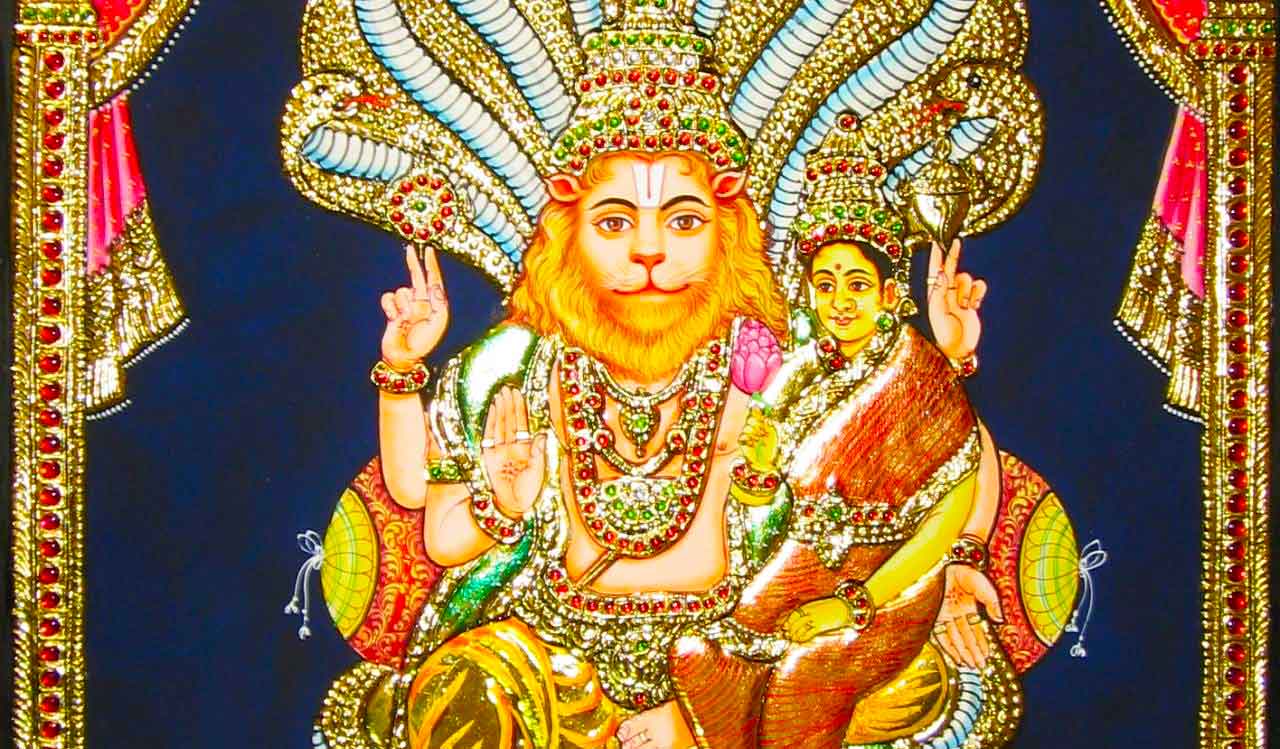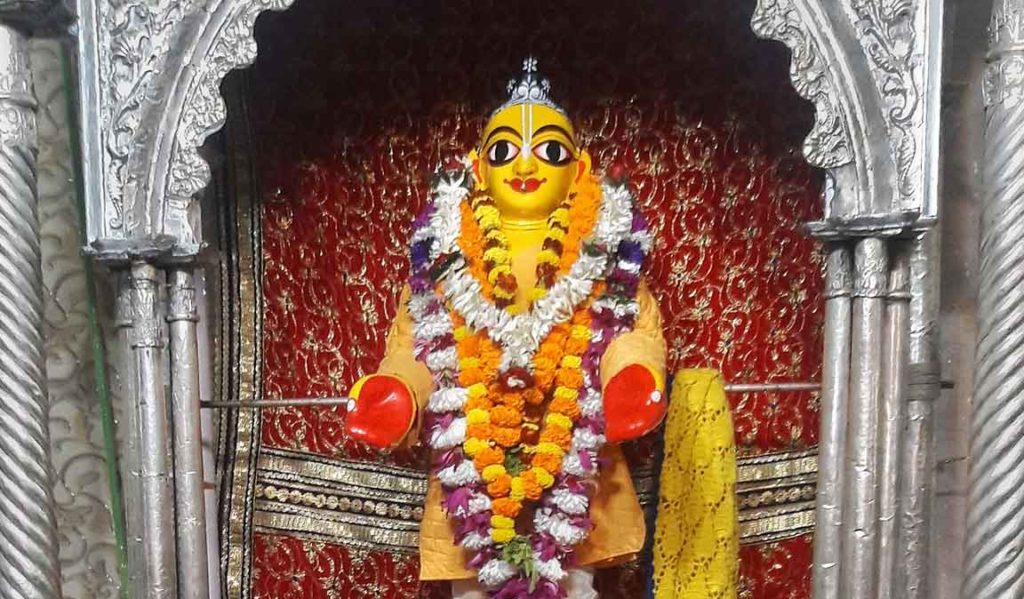Overview
The following is an excerpt from an informal talk by Śrīla Śrīdhara Mahārāja given on the occasion of Śrī Narasiṁha Caturdaśī on May 24th, 1983. Śrīla Śrīdhara Mahārāja discusses Mahāprabhu's journey to the Narasiṁha temples in South India, and the necessity for the devotee to pray for the grace of Narasiṁha.
Today is the advent of Śrī Nṛsiṅghadeva. Of course, He is eternal and He is in Vaikuṇṭha, but He came down here on this particular day to relieve Prahlāda, His devotee, and save him from trouble. We all look up to Him if there is any obstacles or hindrances on the path of devotion.
“O Lord, You saved Prahlāda, so we also file a petition to You to do away with all the obstacles that may come in our way when we try with our small capacity towards the Supreme. Naturally, there may be many difficulties on the path, and You were gracious enough to remove the great difficulties in the case of Prahlāda Mahārāja, so we also expect hope that You will also remove all the thorns that may fall on our path towards our object of our aspiration – Krsna. In my past history, I must have done many things which will come against me, and the illusory energy in general – that also won’t allow me without clearing the debts incurred in so many previous lives under her control. You are the only savior. If You come to our help, then easily all these things may be banished and we may pass over to our desired end. Be especially gracious on us, Nṛsiṅghadeva. We pray to You to do away with the difficulties that may come in the way of our progress. So, particularly with this idea that my belated capital brings some success by Your grace. I am nothing. So many difficulties are sure to stand in my way. Please protect my progress so that I may reach my goal.”
He generally helps the devotees in that way and with that sort of prayer we are to pass this day and observe fasting. After the advent in the evening, we offer pūjā and bhoga to Him and then we shall take some anukalpa. That is our arrangement. The sick or those who are too old may take according to the measure of the occasion – some sweet, liquid or a little milk to keep up the body…otherwise fasting.
In the south, Nṛsiṅgha temples are found more in number. Andhra-deśa is fond of worshiping Nṛsiṅghadeva. There is one temple in Siṁhācalam, near Waltair, then again in Maṅgalagiri near Viyayawada and another Nṛsiṅghadeva in Ahobilam. That is in a forest. Once we went there within that forest, near Warangal in Andhra-deśa. These three temples are all within the boundary of Andhra. One is near Waltair, one near Vijaywada and Ahobilam is far from Warangal, the nearest city. These three temples of Nṛsiṅghadeva are there.
It is mentioned in Caitanya-caritāmṛta that Mahāprabhu visited them. Our Guru Mahārāja also visited those places and constructed the pāda-pīṭha temple of Mahāprabhu in two places – Maṅgalagiri and Siṁhācalam. We were in that party – Vana Mahārāja, myself, Mādhava Mahārāja (who was at that time Hayagrīva Brahmacārī) and two others. We went on installing the pāda-pīṭha of Mahāprabhu there. About twelve hundred steps in Siṁhācalam, six hundred steps to Maṅgalagiri and Ahobilam also. But that was within the forest and rocks, and it was unapproachable. Tigers and other animals are in that forest. Only at daytime one priest comes and offers something in the temple and flies away. That was the position there we saw. Now, I don’t know – that was in the 30’s.
ito nṛsiṁhaḥ parato nṛsiṁho yato yato yāmi tato nṛsiṁhaḥ
bahir nṛsiṁho hṛdaye nṛsiṁho nṛsiṁham ādiṁ śaraṇaṁ prapadye
With this śloka Mahāprabhu climbed up the hill. When we find it is necessary to secure the help of Nṛsiṅghadeva for our benefit, we are to absorb our thoughts wholesale in Him, to remove the difficulties. ‘Here is Nṛsiṅgha, there is Nṛsiṅgha, Nṛsiṅgha is within, Nṛsiṅgha is outside, Nṛsiṅgha is all-in-all.’ With this spirit we have to approach.
śrī-nṛsiṁha, jaya nṛsiṁha, jaya jaya nṛsiṁha
prahlādeśa jaya padmā-mukha-padma-bhṛṅga
You are full of all resources, let victory be with You, then every thing will be peaceful. Jaya, jaya Nṛsiṅgha – victory after victory may spontaneously come through Your will, and that will be beneficial for us fallen souls. Prahlādeśa – You are exclusively sought after by Prahlāda Mahārāja; his connection we can’t sever from you. Jaya Padma-mukha-padma – at the same time we must not forget that You are the object of divine service for Śrī Lakṣmī Devī herself. You have come to take such a hard jungle figure to save Your devotee, but really You are in such a position that Lakṣmī Devī always serves You with her whole heart and energy. Your position is such, but to save Your devotee, You have come in the figure of a half-jungle animal, half human figure, but we won’t forget that Your position is such.
vāg-īśā yasya vadane lakṣmīr yasya ca vakṣasi
yasyāste hṛdaye samvit taṁ nṛsiṁham ahaṁ bhaje
Vāg-īśā means Sarasvatī, the goddess of learning. She is residing in Your face. Lakṣmīr yasya ca vakṣasi – and Lakṣmī Devī, the goddess of resources, is always in Your heart. Yasya ca vakṣasi yasyāste hṛdaye samvit – and within Your heart the seat of real knowledge, real consciousness of the Absolute is there. Samvit means knowledge, the higher consciousness of Your heart. There is consciousness of the Absolute. Even Kṛṣṇa consciousness is also there. I bow down to You repeatedly. In this way so many hints in praise of Nṛsiṅghadeva we find.
ugro ’py anugra evāyaṁ sva-bhaktānāṁ nṛ-keśarī
keśarīva sva-potānām anyeṣām ugra-vikramaḥ
Ugro ’py anugra evāyaṁ – apparently we think Your figure to be a fierce, dreadful form, but really You are very affectionate to the devotee – sva-bhaktānāṁ, anugra. Keśarīva sva-potānām – a lioness is fearful to others, but to her own cubs, she is very affectionate. That is Your position.
namas te nara-siṁhāya prahlādāhlāda-dāyine
hiraṇyakaśipor vakṣaḥ-śilā-ṭaṅka-nakhālaye
I show my obedience to the Lord who is half-human, half-lion, and whose very appearance and necessity is to please His devotee like Prahlāda. For that purpose, to save the devotees, He does not hesitate if necessary to tear up the body of the enemies of the devotee. Hiraṇyakaśipor vakṣaḥ-śilā-ṭaṅka-nakhālaye – the enemy of devotion was Hiraṇyakaśipu and his chest was just like stone. But You tore it to pieces – śilā-ṭaṅka-nakhālaye. In this way we find so many hymns in praise of His grace.
We are devotees, or rather we want to be devotees, so our great need is for the grace of Nṛsiṅghadeva, so that the obstacles will be removed and we can go on smoothly in our way towards our desired Kṛṣṇa consciousness.
Related Articles and Books
- Śrī Dāmodara Kathā – The History of Rādhā Dāmodara Temple (Book)
- Kṛṣṇa-tattva (The Fundamental Reality of Śrī Kṛṣṇa) by Śrīla Bhaktisiddhānta Sarasvatī Ṭhākura
- The Ontological Position of Śrī Śrī Rādhā-Govinda by Śrīla Bhakti Rakṣaka Śrīdhara Deva Gosvāmī
- Śrī Govardhana Pūjā by Śrīla Bhakti Rakṣaka Śrīdhara Deva Gosvāmī
- Śrī Narasiṁha Caturdaśī by Śrīla Bhakti Rakṣaka Śrīdhara Deva Gosvāmī
- Śrī Śrī Rādhā Kṛṣṇa – The Fountainhead of All Tattvas by Śrīla Bhakti Pramoda Purī Gosvāmī
- Kṛṣṇa – The Supreme Vedāntist by Śrīla A.C. Bhaktivedānta Swami Prabhupāda
- Dāsa Gosvāmī and the Unique Position of Govardhana by Śrīla Bhakti Gaurava Narasiṅgha Mahārāja
- The Worship of Govardhana by Śrīla Bhakti Gaurava Narasiṅgha Mahārāja
- Śrī Kṛṣṇa Janmāṣṭamī by Śrīla Bhakti Gaurava Narasiṅgha Mahārāja
- Questions and Answers on Baladeva Tattva by Śrīla Bhakti Gaurava Narasiṅgha Mahārāja
- The Worship of Lord Narasiṁha by Śrīla Bhakti Gaurava Narasiṅgha Mahārāja
- The Dawn of the Age of Love? by Śrīla Bhakti Gaurava Narasiṅgha Mahārāja
Further Reading
- Śrī Kṛṣṇa Saṁhitā by Srila Bhaktivinoda Thakura (Book)
- Impersonal Spirituality and Transcendental Spirituality by Śrīla Bhaktivinoda Ṭhākura
- Servitorship to Kṛṣṇa by Śrīla Bhaktivinoda Ṭhākura
- The Glories of Puruṣottama Māsa by Śrīla Bhaktivinoda Ṭhākura
- Identifying the Supreme Object by Śrīla Bhaktivinoda Ṭhākura
Pilgrimage with Swami Narasiṅgha – Part 7: Keśī Ghāṭa
Continuing with our pilgrimage series, this week Śrīla Narasiṅgha Mahārāja takes us to Keśī Ghāṭā where he tells us about Madhumaṅgala’s meeting with the Keśī demon, what Keśī represents, and how Śrīla Prabhupāda almost acquired Keśī Ghāṭa. Mahārāja also narrates his own experience. This article has been adapted from a number of talks and articles by Narasiṅgha Mahārāja.
Prema Dhāma Deva Stotram with the Narasiṅgha Sevaka Commentary – Verses 61-65
In verses 61 to 65 of 'Prema Dhāma Deva Stotram', Śrīla Śrīdhara Mahārāja narrates the pastime of Śrī Caitanya at Caṭaka Parvata In Purī and explains how the scriptures produced by Brahmā and Śiva are ultimately searching for the personality of Mahāprabhu who is merciful too all jīvas, no matter what their social position.
Prabhupāda Śrīla Sarasvatī Ṭhākura’s Visit to Ayodhyā
With the forthcoming observance of Śrī Rāma Navamī, we present 'Prabhupāda Śrīla Sarasvatī Ṭhākura’s Visit to Ayodhyā' written by Śrīla Bhaktisiddhānta Sarasvatī Ṭhākura Prabhupāda from The Gaudīyā magazine, Vol 3. Issue 21/ In December 1924, after visiting Benares and Prāyāga, Sarasvatī Ṭhākura visited the birth-site of Śrī Rāmācandra in Ayodhyā.
Śaraṇāgati – The Only Path to Auspiciousness
In this article, 'Śaraṇāgati - The Only Path to Auspiciousness', Dhīra Lalitā Dāsī analyses the process of śaraṇāgati (surrender) beginning with śraddhā (faith). She also discusses the role of śāstra and the Vaiṣṇava in connection with surrender.
Pilgrimage with Swami Narasiṅgha – Part 7: Keśī Ghāṭa
Continuing with our pilgrimage series, this week Śrīla Narasiṅgha Mahārāja takes us to Keśī Ghāṭā where he tells us about Madhumaṅgala’s meeting with the Keśī demon, what Keśī represents, and how Śrīla Prabhupāda almost acquired Keśī Ghāṭa. Mahārāja also narrates his own experience. This article has been adapted from a number of talks and articles by Narasiṅgha Mahārāja.
Prema Dhāma Deva Stotram with the Narasiṅgha Sevaka Commentary – Verses 61-65
In verses 61 to 65 of 'Prema Dhāma Deva Stotram', Śrīla Śrīdhara Mahārāja narrates the pastime of Śrī Caitanya at Caṭaka Parvata In Purī and explains how the scriptures produced by Brahmā and Śiva are ultimately searching for the personality of Mahāprabhu who is merciful too all jīvas, no matter what their social position.
Prabhupāda Śrīla Sarasvatī Ṭhākura’s Visit to Ayodhyā
With the forthcoming observance of Śrī Rāma Navamī, we present 'Prabhupāda Śrīla Sarasvatī Ṭhākura’s Visit to Ayodhyā' written by Śrīla Bhaktisiddhānta Sarasvatī Ṭhākura Prabhupāda from The Gaudīyā magazine, Vol 3. Issue 21/ In December 1924, after visiting Benares and Prāyāga, Sarasvatī Ṭhākura visited the birth-site of Śrī Rāmācandra in Ayodhyā.
Śaraṇāgati – The Only Path to Auspiciousness
In this article, 'Śaraṇāgati - The Only Path to Auspiciousness', Dhīra Lalitā Dāsī analyses the process of śaraṇāgati (surrender) beginning with śraddhā (faith). She also discusses the role of śāstra and the Vaiṣṇava in connection with surrender.








